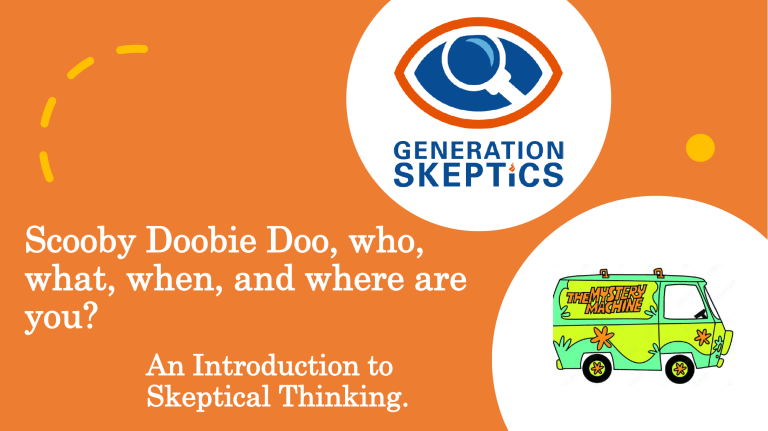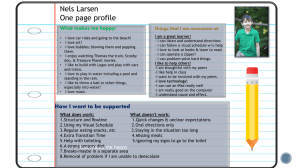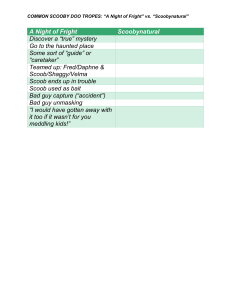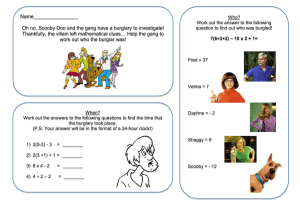
Scooby Doobie Doo, who, what, when, and where are you? An Introduction to Skeptical Thinking. Scooby and the Gang are skeptics. Based on what you know about Scooby, what do you think a skeptic is? Vocabulary • Skeptic: a person who questions or doubts accepted opinions. • Skepticism: an approach to evaluating claims, or a person’s position on a topic, that emphasizes evidence and applies tools of science. • The Skeptical process considers evidence obtained by systematic observations and reason. • The conclusion that is reached at the end of this process is subject to change, because additional or better evidence may come along that points towards a more suitable explanation. Today we will focus on just a few ways skeptics analyze information: Asking Questions Paying attention to details Considering the source of the information Now, let’s think of ways we use skeptical thinking … Pretend you are going on a trip. What do you need to ask (know) to plan what you will take? Think the 4 Ws + H: • Who • What • Where • Why • How You are online and see a story about a candy that, if eaten daily, prevents cavities. Your first reaction is to say, “Awesome! Where can I buy it?” But you know better, right? What do you do next? Think the 4 Ws + H: Who What Where Why How You want the latest version of your favorite game. You are watching your favorite show and a commercial comes on. The new game price is very low compared to the prices you saw at the store and online. What questions should you ask to be sure this is a legitimate sale? Think the 4 Ws + H: Who What Where Why How Let’s review the strategies that we’ve talked about: • WHO is giving you information and what motivated them. • Ask Questions, questions, and more questions. • Pay attention to details. Let’s watch a few minutes of a Scooby Doo episode. Keep your eyes open! Episode Analysis: Who What When Where, Why, How? • Who are the characters? • What is the mystery they need to solve? • Why do the kids think there is a ghost? What did you see or hear that makes you say that? • What was really going on? What did you see or hear that makes you say that? Scooby and the Gang? • Who told them the house was haunted? • Why did he tell them the house was haunted? What was his motivation? • They used skepticism to solve the mystery of the haunted house by asking questions, paying attention to details and discovering who was “haunting” the house and why. Now that we’ve practiced skeptical thinking, remember to use it to find answers to your questions. As Velma says: “There’s a very logical explanation for all this.” “Scooby Doobie Doo!” Now, how about some Scooby Snacks? Teacher Notes • This lesson is and introduction to skeptical thinking. It is about an hour in length including the Scooby Doo episode. This lesson is recommended for children grades 1-5. • There are worksheets that accompany the discussion slides 8-10. These could be completed individually or in small groups. • I recommend Scooby Doo Where are You? Season 2 Episode 5 “Haunted House Hang up”. I purchased this on Amazon Prime Video ($1.99) and downloaded it. I show this after we discuss the vocabulary on slide 3 and the strategies on slide 4. RL 1.2 Retell stories, including key details, and demonstrate understanding of their central message or lesson. ELA Common Core Standards Grades 1-5 RL 2.1 Ask and answer such questions as who, what, where, when, why, and how to demonstrate understanding of key details in a text. RI 2.1 Ask and answer such questions as who, what, where, when, why, and how to demonstrate understanding of key details in a text. RL. 3. 1. Ask and answer questions to demonstrate understanding of a text, referring explicitly to the text as the basis for the answers. RI. 3.1 Ask and answer questions to demonstrate understanding of a text, referring explicitly to the text as the basis for the answers. RL and RI 4.1Refer to details and examples in a text when explaining what the text says explicitly and when drawing inferences from the text. W.5.9.A Apply grade 5 Reading standards to literature (e.g., “Compare and contrast two or more characters, settings, or events in a story or a drama, drawing on specific details in the text [e.g., how characters interact]”). W.5.9.B. Apply grade 5 Reading standards to informational texts (e.g., “Explain how an author uses reasons and evidence to support particular points in a text, identifying which reasons and evidence support which point[s]”). Elementary Standards • Reading/Viewing • Explain how setting, events, conflict, and character development contribute to the plot in a literary text. Analyze an author’s purpose and/or perspective in an informational text. Explain an author’s claim and the reasons and evidence used to support the claim. • Context and connotation: • Use context clues, figurative language, word relationships, reference materials, and/or background knowledge to determine the meaning. Resources and References • Kenny Biddle is a science enthusiast who investigates claims of paranormal experiences, equipment, photos, and video. He promotes science, critical thinking, and skepticism through his blog I Am Kenny Biddle. He frequently hosts workshops on how to deconstruct and explain paranormal photography. Email – parainvestigator@comcast.net This slide was created by Kenny Biddle (see previous slide). This was used as a reference. Resources and References • Instagram Scams • https://us.norton.com/blog/online-scams/instagram-scams# • 6 false Advertising Scandals You Can Learn From. • https://www.entrepreneur.com/growing-a-business/6-falseadvertising-scandals-you-can-learn-from/314326 use is the subject of a documentary. This lesson is brought to you by Generation Skeptics GenSkeps aims to develop and foster an understanding of the world through inquiry-based learning. We provide material to complement and enhance existing science and educational programs. The Generation Skeptics Program is a program of the Center for Inquiry. Check out the Generation Skeptics Website







